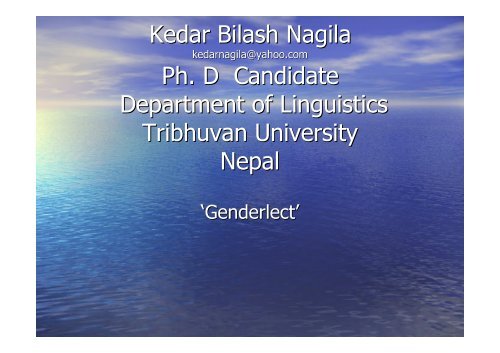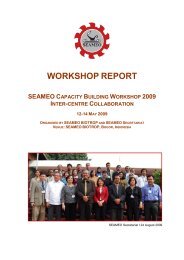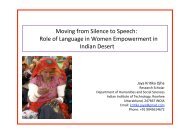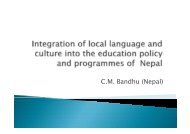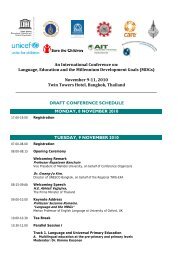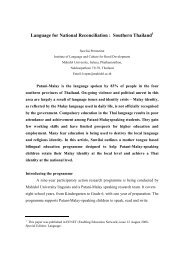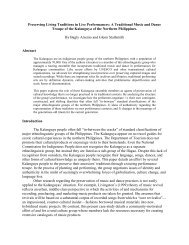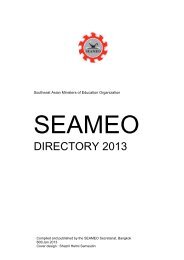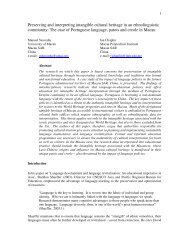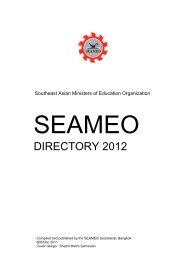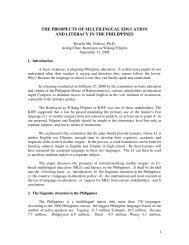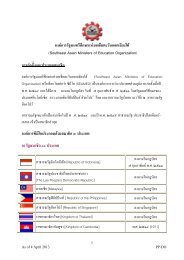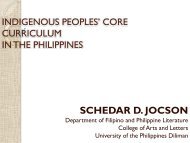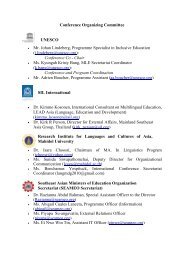Kedar Nagila - thailand power point
Kedar Nagila - thailand power point
Kedar Nagila - thailand power point
You also want an ePaper? Increase the reach of your titles
YUMPU automatically turns print PDFs into web optimized ePapers that Google loves.
<strong>Kedar</strong> Bilash <strong>Nagila</strong><br />
kedarnagila@yahoo.com<br />
Ph. D Candidate<br />
Department of Linguistics<br />
Tribhuvan University<br />
Nepal<br />
‘Genderlect Genderlect’
Why is this paper interesting?<br />
• A language considerd to be extinct but has 3327 out of the<br />
total population 5,169(2001)<br />
• Ethnic group that identifies the language as being part of their<br />
heritage but no one still speaks the language<br />
• Argots that confuse to identify language.<br />
• The Gurungs who speak the language but refer it as<br />
Tandrange Bhu. Bhu<br />
• It has genderlect (Tannen ( Tannen 1994) which views communication<br />
between men and women through a humanistic and scientific<br />
approach. Genderlect mainly states that the differences<br />
between the communication styles that women and men use<br />
are cross cultural.(tp://www.modlinguistics.com/<br />
cultural.(tp://www.modlinguistics.com<br />
Sociolinguistics/gender/Critique%20of%20Genderlect%20Theor<br />
y.tm)
Who are the Dura people?<br />
• Purang north west of China.(personal<br />
communication with J.P Cross)<br />
• Durankot,the highland in between Manage nad<br />
Mustang.(Narharinath 1956)<br />
• Rulers of Dullu, Dullu,<br />
Dailekh (Dura ( Dura Sewa samaj 1994)<br />
• Heartland of Duras is Dura Danda in Lamjung in<br />
Gandaki zone in west Nepal and now have<br />
migrated in 12 districts in Nepal.
Previous study on the Dura ethnic<br />
group<br />
• Gurung H.(1976) an introductory sentence.<br />
• Thapa K.B (1981) origins and history<br />
• Adhikari R.(1984/85) introductory book<br />
• Gurung G.(1988) sociological study<br />
• Madage L.(1985) anthropological study<br />
• Ghimire M.(1993) an outline of grammar<br />
• Ghimire M.(2001) Revised version of 1993.
Previous studies on the Dura<br />
langauge<br />
• Shafer(1966) Magaric dialect along Raji,Raute,…<br />
Raji,Raute<br />
• Hale(1982) Magaric dialect based on Toba’s Toba information.<br />
• Bradley(1997) Bodish language<br />
• Driem(2001) Tibeto-Burman language/yet to be identified.<br />
• Populatin Census,Nepal(2001) Dura language with the total mother tongue<br />
speakers 3327.<br />
• Toba and Rai(2002) West Himalyaish ,Tibeto , Tibeto Burman language<br />
• <strong>Nagila</strong>(2006) A trilibgual Dictionary<br />
• <strong>Nagila</strong> (2007) A sketch grammar<br />
• Noonan (2007) Central Bodish language.<br />
• Lewis(2007) Tibeto-Burman (extinct) information based Driem(2001)<br />
• Lewis(2009) West Himalayish, Himalayish,<br />
Tibeto-Burman extinct language of whose<br />
speakers have shifted to the Nepali language.
Different surnames<br />
• Dura-Gurung<br />
• Gurung<br />
• Rana<br />
• Thapa-Dura<br />
• Thapa<br />
• Rai<br />
• Ale Magar
Reasons of adopting Different<br />
surnames<br />
• Sanskirtization (Gurung ( Gurung 1988)<br />
• Getting recruited in the British ,Indian and<br />
Nepal Armies (Thapa ( Thapa 1981)<br />
• Being the part of majority in the society.<br />
(<strong>Nagila</strong> <strong>Nagila</strong> 2006)<br />
• Climbing the social ladder (Driem ( Driem 2001)
Difference between Dura and<br />
Gurung in term of culture<br />
• Duras have been living in Dura Danda and look like<br />
the Gurung in appearance and feature . They have<br />
been serving in the war as Gurung but not identified as<br />
the Duras. Duras.<br />
They have adopted surnames Gurung, Gurung<br />
Thapa, Thapa,<br />
and Rai because of chance of getting easier<br />
to the British ,the Indian and the Nepal.<br />
• Duras have practice and celebrate rodi,Ghantu<br />
,,putpute,noga<br />
putpute,noga r r (working together turn by turn) of the<br />
Gurung and the dresses and ornaments of the Duras<br />
are similar to that of Gurungs (Gurung ( Gurung 1988:52).
Continued…<br />
Continued<br />
• Similarly, Duras drink liquor, chicken,<br />
mutton, buffalo and pork. But the<br />
Gurungs do not eat pork because of<br />
which Duras are looked upon down.<br />
• One of the Dura informant reported me<br />
that there are some Dura-Gurung who<br />
had changed t surnames after paying<br />
Panch Panch mohar mohar and sat sat mohar mohar to Pancha Pancha<br />
bhaladmi bhaladmi in the past. The Gurung<br />
celebrate lhoshar lhoshar on 15th Poush<br />
(approximately 1 January<br />
• every year) whereas the Dura celebrate on<br />
1st of Magh (approximately 15 January
Sociolinguistic status<br />
• No language use and loyality. loyality<br />
• No language vitality<br />
• The statistics of the Government false.<br />
• Real Duras knows phrase, tit and bits of words.<br />
• But Gurung very vital, loyal and use language<br />
in every domains of langauge use.<br />
• The gurung<br />
autogloname as tabdrange<br />
bhu(language as it is spoken in their area)
• Preliminary linguistic features<br />
• No agreement pattern in<br />
number,gender,number.<br />
number,gender,number<br />
• plural marker<br />
• causative marker<br />
• < > > nnegative markers<br />
• > non past, > past tense <br />
prog and > inferential markers.
Dura as Dorment and secret<br />
language<br />
• 75% reported me that their language was the ‘secret secret<br />
language’ language spoken during the time of war in the<br />
palace, army castle, and sentry.<br />
• 30% percent of the informants said that it is<br />
spoken only in Tandrrange Gurung .<br />
• The Gurungs who speak as mother tongue speakers<br />
would strongly protest and would not speak or provide<br />
data for further investigation in terms of status,<br />
hierarchy and economical and social status of the the<br />
Gurung who considered themselves as the most<br />
sophisticated and higher in cultural dignity .
Continued…..<br />
Continued ..<br />
• I have taken observational interviews and administered<br />
sociolinguistic questionnaires 30 native speakers depending on<br />
age, sex and literacy who are all Gurungs and use autoglotynym<br />
Tandrange Tandrange bhu bhu unanimously. The Dura people whom I<br />
encountered did not provide me the Swadesh Word List -<br />
100(1955) more than 25% in my collection. However, they claim<br />
that the language spoken by Gurungs in Tandrange is their mother<br />
tongue. One of the Dura young man was fired with me not to<br />
autoglotynym as Tandarnge Tandarnge kura kura . Then I asked him few words to<br />
tell me in Dura and turned shy and apologetic immediately. The<br />
Gurungs whom I have selected as the informants want to be sure<br />
that data should not be used as the lexicons of the Dura language<br />
and proud of being speakers of such language isolate.
Gender distinction in the<br />
colloquial Dura language<br />
.<br />
• Most language in the world posses a number of mechanism to show<br />
politeness or solidarity (Brown and Levinson, 1987) which range<br />
from an elaborate honorific system to the usages of indirect<br />
utterance (subjunctive form, negative form etc.)<br />
• Apart form it the Dura language has a ‘genderlect genderlect’ (Tannan ( Tannan 1994)<br />
speech style which denote the sex of the speakers. However, they<br />
are not marked in formal situation and difference in the choice of<br />
particular syntactic morphological and lexical form. Research<br />
suggest that men and women talk differently in Hindu culture too.<br />
In Hindu society, Nepali language speaker women has been<br />
associated with cooperation and politeness whereas men are<br />
described as aggressive and dominant .Nepali language has first<br />
level honorific, second level honorific, third level (low) honorific,third<br />
level (mid) honorific, third level (high) honorific.
pronouns<br />
• The pronouns in the Dura language are / Ni /<br />
I /NeHro / NeHro/ / We /no/ You /no / You , /hui / hui/, /, (he<br />
she ) / i / I t , /Hjero / Hjero/ / ‘they they’ .There are<br />
basically one set of pronouns in the second<br />
person .The second person of the men is / no<br />
/ ‘you you’ while females use / noai noai / ‘you you’ in<br />
colloquial form and formal situations. Women<br />
normally perform / ni / ‘I’ whereas men /Ni<br />
/ ‘I’ in first person personal pronoun.
verbs<br />
• The morpheme / i / is the infinitive marker in the Dura language. There<br />
are two copular verbs: identificational and existential . >. Verbs<br />
are made polite suffixing > regardless of tense and mood. While both<br />
males and females can use plain endings in informal situations; women<br />
opt to use the polite forms while making discourse with male in<br />
particularly to husbands. Only men use imperative form while women use<br />
imperative forms in quarrellings. Women are generally expected to use the<br />
suffix /aie / aie/ / suffix which is suffixed to make polar question by the men.<br />
For example/ c#oi / is affirmative imperative and is exclusively used by<br />
men whereas women use / c@obaie/to c@obaie/to<br />
be polite and submissive. Men also<br />
can use this form but they do not prefer to show politeness to<br />
womanhood and rather prefer to be commanding. These feminine forms<br />
are associated with softness and politeness. For example, I have<br />
presented the following .The situation was the first meeting of this<br />
researcher with 41 years old female informant in Tanahun. Tanahun.<br />
Men use <br />
in place of in unfamiliar conversation and speak in fast speed. The<br />
use of the copular le is ffrequent in women conversation than the men’s men s c
Word order<br />
• The basic word order of the language is SOV. Women use seem to be using be less<br />
conservative in applying grammatical rules than men. They tend to omit some<br />
particle more often than men .<br />
• Drawing the work of brown and Gilman (1960) and Brown and Levinson(1978) this<br />
study describes how and when address form such as pronouns ,kinship terms ,<br />
tekonymms ,personal names and other strategy like taboos and euphemism are<br />
used by the Dura in their verbal interactions in order to convey the aspect of<br />
politeness. The polite form of the non past tense marker > seem to be <br />
in form of women. Similarly, the negative prefix has allophonic variation<br />
/mo/,/mu /mo/,/ mu /,/ma /. The numerals of the men are heavily borrowed from the Nepali<br />
language whereas women have kiute<br />
‘one one’nerki nerki ‘two two’serkiu serkiu three,tari<br />
‘four four’<br />
tarkiu ‘five five’ naski<br />
‘six six’ kar ‘ten ten’. At the discourse level, women tend to use more<br />
polite language than men. Increased use of the suffix/ aie / to the verb denote<br />
honorific status and found more pronounced in female speech. Let’s Lets<br />
see the<br />
following. The same informant spoke to me in this polite way.
Power and solidarity in<br />
gender and dominance.<br />
dominance<br />
• The dynamics of <strong>power</strong> and solidarity have been fundamental to<br />
sociolinguistic theory (Fasold ( Fasold ,1990). Brown and Gilman (1960) based<br />
their framework on the analysis of the use of pronouns in European<br />
languages which have two forms of the second person pronoun such as<br />
French tu and vous. vous.<br />
In English the closest parallel is to be found in the<br />
form of address: first name versus title last name. As reported, the Dura<br />
society was matriarchal and the new generation of the Duras have<br />
recently declared that they have decided to register their property in the<br />
name of their females in particularly wives. Not only that, they have<br />
proposed to make Dura colony in Kathmandu to preserve and promote<br />
language and culture.The gender difference and discrimination is not overt<br />
in this language. Watching the conversation of the males and females, I<br />
have observed that there are patterns which link the speakers of like<br />
gender across ages. At every level, women oriented to each other with the<br />
alignment of their bodies and gaze far more directly than did men. But the<br />
new generation has shifted to the Nepali languages and no more speaks<br />
the language their ancestors speak in the domain of households.
Thank all of you for<br />
listening, making quries<br />
and interestsing.<br />
interestsing


